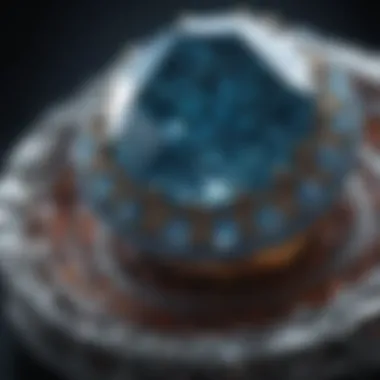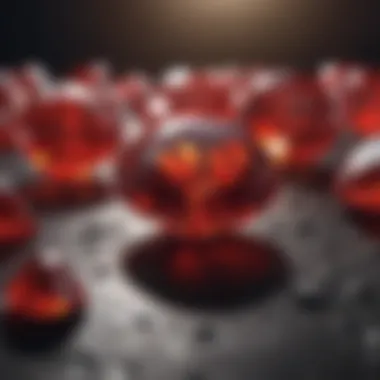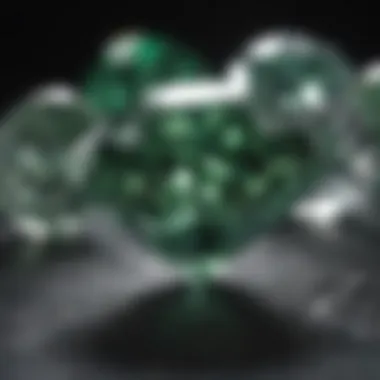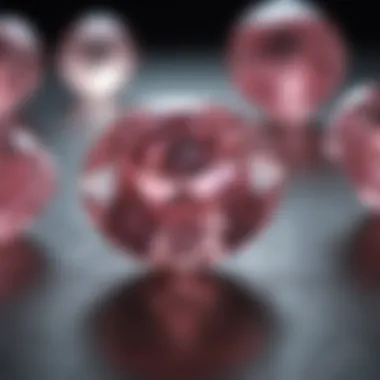Unveiling the Rarest Colors of Natural Diamonds


Intro
Natural diamonds are more than mere gemstones; they are pieces of the Earth's history, shaped by immense pressure and time. Among the myriad of shades diamonds can exhibit, some colors are incredibly rare, elevating their status to coveted treasures. This article delves into the rich tapestry of rare diamond colors, uncovering their characteristics, the processes that lead to their formation, and their significance in culture and commerce. By examining colors such as blue, red, green, and pink, we will explore the stories they tell about geological phenomena and human appreciation.
Gemstone Overview
Definition and characteristics
Diamonds are crystalline forms of carbon. Their formation occurs deep within the Earth, where heat and pressure coalesce to create unique crystal structures. Rarity in color is attributable to various factors, including the presence of trace elements, structural anomalies, and natural radiation.
Diamonds can be classified by different criteria.
- Color: Diamonds are known for their classic colorless variety, but the colored diamonds can range from faint tints to vivid hues.
- Clarity: This refers to the presence of inclusions or flaws that can affect the diamond's visual appeal.
- Cut: The manner in which a diamond is shaped affects its brilliance and overall aesthetics.
- Carat weight: The size of the diamond, impacting rarity and value.
Classification of gemstones
The classification of gemstones includes two main categories: precious and semi-precious. While diamonds are generally considered precious, the distinction of their colors plays a crucial role in determining their value. For instance, a vivid blue diamond is not only rare but can command prices that far exceed those of a colorless diamond.
Properties of Gemstones
Physical properties
The physical properties of diamonds make them highly desirable. Diamonds are graded on their hardness, and they are the hardest known natural material. They also exhibit a high degree of brilliance due to their unique ability to refract light. This optical property can vary significantly with color intensity.
Chemical properties
From a chemical perspective, the primary component of diamonds is carbon. However, color variations emerge from the incorporation of different elements. For example, the presence of boron can lend a blue hue, while nitrogen can create yellow tones. Understanding these chemical properties helps in distinguishing and valuing rare diamonds in the market.
Prelude to Diamond Color
Understanding the intricacies of diamond color is fundamental in the realm of gemstones. Color characteristics can significantly influence the overall assessment and appeal of a diamond. The grading system that determines a diamond's hue plays a vital role in its valuation and desirability among collectors and jewelers alike. Natural diamonds come in a vast array of colors, but the rarest hues command particular attention for their beauty and scarcity. Consequently, a thorough exploration of diamond color paves the way for deeper appreciation and investment potential.
Understanding Diamond Color Grading
Diamond color grading is primarily conducted using a scale established by the Gemological Institute of America (GIA). The scale runs from D (colorless) to Z (light yellow or brown). Colorless diamonds are often the most sought after; however, colored diamonds possess unique allure due to their rarity. When grading diamonds, several factors come into play:
- Hue: The basic color or combination of colors. Each diamond can display multiple nuances.
- Tone: Refers to the lightness or darkness of the color.
- Saturation: Indicates the intensity of the color; more saturated colors usually have greater value.
Colored diamonds may also be described using terms like "fancy" if they have a strong, vivid hue. The grading of color is intricate; it requires not only a scientific approach but also an appreciation for the artistic aspects of gemology. Hence, understanding these grading dynamics enriches one’s perspective on the diamond market.
Color vs. Clarity in Gemstones
Color and clarity are both pivotal factors in the beauty and value assessment of gemstones, but they emphasize different aspects of a diamond's appeal. Color focuses on the visible hue and shade that a diamond emanates, while clarity addresses the internal imperfections known as inclusions or external blemishes. Clarity is graded by evaluating the type, size, and position of these imperfections.
- A highly clear diamond can sometimes fetch a higher price even if it exhibits a less-desirable color.
- Conversely, a colorful diamond with minimal clarity flaws can also command premium pricing, especially if it belongs to a rare color category like red or blue.
Both characteristics are interdependent in the gemstone landscape. For enthusiasts and collectors, finding a balance between color and clarity is essential, as optimal combinations can lead to exceptional pieces in collections. Understanding these factors not only enhances the selection process but also prepares one for future investments in gems.
The Formation of Diamond Colors


Understanding the formation of diamond colors is crucial for grasping the overall allure and rarity of these gemstones. The process by which diamonds acquire their unique colors is influenced by various factors including the geological environment, impurities, and specific conditions under which they form. This section explores the distinctions between natural and synthetic diamonds as well as the geological processes that lead to the creation of different diamond colors. Both aspects are vital for enthusiasts who seek to appreciate the complexity of diamond characteristics and value.
Natural vs. Synthetic Diamonds
Natural diamonds form deep within the Earth’s mantle, at depths ranging from 150 to 250 kilometers beneath the surface. This process takes place over millions of years under extreme pressure and temperatures, allowing carbon atoms to crystallize into a diamond structure.
On the other hand, synthetic diamonds, created in laboratories using methods like High Pressure High Temperature (HPHT) or Chemical Vapor Deposition (CVD), can exhibit similar physical and chemical properties to natural diamonds. However, the colors of synthetic diamonds often differ since they are produced under controlled conditions that do not replicate the natural geological processes.
Here are some key points that differentiate natural and synthetic diamonds:
- Source: Natural diamonds originate from geological processes, while synthetic diamonds come from human-made methods.
- Color Variation: Natural diamonds can exhibit a wider range of colors influenced by various geological factors including temperature, pressure, and the presence of trace elements. Synthetic diamonds may show colors designed intentionally but with less variation than natural counterparts.
- Value: Generally, natural diamonds hold greater value, especially those with rare colors. Synthetic diamonds typically have lower market prices and do not command the same prestige in the gem market.
Geological Processes Influencing Color
Several geological factors play a crucial role in determining the hue of a diamond. Different conditions during formation can introduce various trace elements into the crystal lattice of the diamond, influencing its color:
- Boron Presence: Diamonds that look blue often contain boron, a trace element that absorbs red light. This makes the diamond appear blue under natural light conditions.
- Nitrogen Influence: Yellow diamonds are usually caused by the presence of nitrogen atoms, which distort the crystal lattice and absorb blue light. The more nitrogen present, the more intense the yellow hue becomes.
- Radiation Exposure: Green diamonds get their color due to radiation exposure from nearby elements. This natural process creates a unique hue virtually absent in synthetic alternatives.
Geological processes influencing color can significantly affect the diamond's appearance and value. Enthusiasts and collectors should consider these elements to deepen their appreciation for these rare gems.
"Each diamond color tells a story about its formation and the geological history of our planet."
Rare Natural Diamond Colors
The exploration of rare natural diamond colors uncovers layers of significance within the world of gemstones. These colors, often elusive and difficult to find, represent not just the aesthetic value but also the geological history, cultural symbolism, and investment potential. Understanding these unique hues provides essential insights for gemstone enthusiasts, collectors, and professionals in the jewelry industry.
Rare diamond colors correlate closely with their formation processes. Factors like environment, temperature, and trace elements contribute to their striking appearances. This informs buyers not only about aesthetic choices but also about the rarity and provenance of the gems. Furthermore, as market demand for colored diamonds rises, recognizing the nuances of these colors becomes crucial for making informed purchasing decisions.
Blue Diamonds: The Deep Sea of Color
Blue diamonds, often regarded as the most intriguing of all colors, are prized for their stunning azure hues. The allure of these gems lies in their striking color, which results from the presence of boron during the crystal's formation. The more vivid the hue, the more valuable the diamond can be. Notable examples include the renowned Hope Diamond and the Blue Moon Diamond, both of which showcase the captivating beauty of this rare color.
The deep, ocean-like color evokes a sense of mystery and elegance. Special treatment of blue diamonds, such as their cutting and polishing, can greatly influence their final appearance. This adds yet another layer of complexity for collectors and designers, as different cuts reflect light uniquely, enhancing the visual experience of the stone.
Red Diamonds: The Pinnacle of Rarity
Red diamonds are exceptionally rare, making them the most coveted color in the diamond spectrum. They derive their hue from unique atomic structure and the way light interacts with the stone. Less than twenty known red diamonds exist, which adds to their mystique. The Moussaieff Red Diamond is perhaps the most famous example, known for its deep red color and flawless quality.
Due to their scarcity, red diamonds are often thought to symbolize passion and strength. Their extreme rarity ensures that they command staggering prices at auctions. Investors and collectors recognize that owning a red diamond signifies access to an elite tier of gemstone ownership.
Green Diamonds: An Element of Nature
Green diamonds are fascinating for their subtlety and connection to nature. Their unique shades arise from radiation exposure during their formation. Unlike other rare colors, the green hue can vary greatly, ranging from faint to deep tones. One notable example is the Dresden Green Diamond, known for its historical significance and striking green hue.
This color symbolizes growth and vitality, resonating well with those who appreciate nature-inspired elements. Green diamonds are often less recognized compared to other hues, making them an interesting option for collectors seeking something distinctive.
Pink Diamonds: A Delicate Spectacle
Pink diamonds captivate with their gentle hues and rarity. The specific cause of their color remains somewhat of a mystery, but it is generally attributed to changes in the crystal structure during formation. The Argyle Mine in Australia was famed for producing a significant portion of the world's pink diamonds until it closed in 2020.


These diamonds exude a sense of charm and romance, often associated with love and femininity. Their appeal lies not only in their delicate color, but also in the prestige they carry in the market, making them both a personal indulgence and a valuable investment.
Orange Diamonds: A Colorful Exception
Orange diamonds are a vivid expression of color that stands out in a collection. Their hue comes from a combination of nitrogen in the diamond's structure. The Pumpkin Diamond, a famous orange specimen, showcases this color beautifully.
These diamonds symbolize enthusiasm and creativity, making them popular choices among collectors wanting to make a bold statement. Though not as common as others, their rarity and unique appeal ensure they remain in demand.
Yellow Diamonds: Subtle Yet Striking
Yellow diamonds, often seen as the more accessible option in the colored diamond market, are not to be underestimated. The color ranges from light canary shades to deeper golden tones, depending on the nitrogen concentration during formation. The Tiffany Yellow Diamond is a notable example, famous for its large, vivid yellow appearance.
Often associated with optimism and happiness, yellow diamonds are popular in a range of jewelry styles. Their increasing popularity can draw interest from both collectors and wearers alike, making them a solid addition.
Purple Diamonds: Royal Hues of Mystery
Purple diamonds present an enchanting color, often regarded as a royal hue due to their association with wealth and nobility. Their color results from trace amounts of hydrogen within the diamond's crystal structure. The famous Purple Orchid Diamond highlights this color's unique allure.
This rare color can evoke a sense of elegance and mystery, appealing to those who seek less conventional choices. Purple diamonds hold significant value, making them both alluring for personal adornment and investment.
The Value of Rare Diamond Colors
The value of rare diamond colors encompasses not just their monetary worth, but also the multifaceted significance they hold in various contexts. This section aims to illuminate the many aspects of the valuation process which include market demand, investment potential, and the nuances that dictate price variations. Understanding these elements is vital for gemstone enthusiasts and collectors as it provides insights into trends and future possibilities regarding colored diamonds.
Market Demand and Pricing Trends
Rare diamond colors enjoy a unique position within the gem market. The rarity of certain hues like blue, pink, or red diamonds contributes significantly to their high demand among collectors and investors. The market operates dynamically, influenced by factors such as trends in luxury goods, celebrity endorsements, and the preferences of affluent buyers.
For instance, recent auction results have shown skyrocketing prices for colored diamonds. The rise in popularity can often be traced back to high-profile purchases, which tend to create buzz and drive demand. Moreover, demand for colored diamonds does not just come from private collectors; there is also a notable interest from investors looking to diversify their portfolios.
Analysts have noted that blue diamonds, particularly those similar to the Hope Diamond, can fetch prices above a million dollars per carat. This trend underlines the importance of understanding color rarity as it directly correlates with market valuation.
Investment Potential of Colored Diamonds
Investing in colored diamonds has gained traction as a viable alternative asset class. Their intrinsic rarity often yields a higher return compared to traditional investments such as stocks or bonds. The finite nature of these gems coupled with the increasing interest in them outside of the traditional luxury market makes them appealing for diversifying investment portfolios.
The investment potential is particularly significant for diamonds that exhibit unique color characteristics, such as vivid hues or exceptional clarity. Investors should be aware that the market is subject to fluctuations, thus careful consideration for appraisal and sourcing is essential. %Following recommended guidelines can help mitigate risks.
A well-informed investor will consider factors like color intensity, provenance, and market trends to make savvy investment decisions.
Factors Influencing Price Variations
Several key factors govern how the pricing of rare diamond colors varies:
- Color Quality: Shades that are deeper and more saturated tend to command higher prices.
- Size and Carat Weight: Larger stones are generally rarer and fetch higher values.
- Market Trends: As trends shift, so does the desirability of particular colors.
- Certification: Having a reputable certification can enhance a diamond's value significantly.
Cultural Significance of Diamond Colors
The cultural significance of diamond colors extends beyond mere aesthetics; it embodies symbols, identities, and aspirations across various societies. Different cultures have ascribed unique meanings to the colors of diamonds that reflect values, beliefs, and historical narratives. This section aims to illuminate how colors of diamonds resonate within cultural contexts and their implications for both individuals and societies at large.


Symbolism Across Cultures
Different cultures attribute various meanings to diamond colors. For instance, blue diamonds, often associated with tranquility, evoke feelings of peace and harmony. In contrast, red diamonds symbolize passion and love, making them highly sought after in romantic engagements. Here are some examples of the meanings attributed to certain diamond colors:
- Yellow diamonds are often connected with joy and positivity in Western societies.
- Green diamonds, linked with nature and fertility, have significant ties in many cultures.
- Pink diamonds represent sweet love and affection, frequently used in jewelry for special occasions.
These interpretations highlight that the perceived rarity of a diamond color can enhance its story, creating an emotional connection with buyers or wearers. This is especially true for jewelry designers and collectors, who may curate pieces that reflect specific cultural sentiments.
Historical Context and Significance
Historically, the perception of diamond colors has evolved, mirroring changes in societal values and artistic preferences. In ancient contexts, diamonds were considered rare and possessed mystical properties, often regarded as symbols of protection and strength. For instance, blue diamonds like the Hope Diamond carry legends that suggest they hold magical qualities, embodying both allure and trepidation throughout history.
In more recent times, the rise of fine jewelry trends has elevated the status of colored diamonds. The introduction of colored diamonds into mainstream luxury markets coincided with shifting consumer preferences for uniqueness and individuality. Notable events, such as Elizabeth Taylor's famed collection featuring colored diamonds, linked these gems to celebrity and wealth, cementing their role in popular culture.
Through history, the significance of diamond colors has remained fluid, yet it consistently underscores themes of rarity, desirability, and societal values. The emotional weight of colored diamonds influences their perceived value in a social context, further accentuating their importance in personal and cultural narratives.
"Colored diamonds are not just stones; they are stories embedded in the cultural fabric of society."
Understanding the cultural significance of diamond colors adds depth to the appreciation of these gemstones. As trends continue to change, the dialogues around colored diamonds will also evolve, reflecting contemporary values while holding on to their historical significance.
Ethical Considerations in the Diamond Industry
The diamond industry has faced numerous ethical challenges, especially regarding the sourcing and extraction of these precious stones. As colored diamonds gain prominence, awareness about their ethical implications becomes increasingly crucial. Consumers today value transparency and responsibility in their purchases. Understanding these ethical considerations enables informed decisions and promotes sustainable practices in the gemstone market.
One major concern involves the sourcing practices for colored diamonds. Unlike conventional diamonds, colored diamonds often come from regions where regulatory oversight may be lax. This raises questions about human rights abuses, labor conditions, and the potential funding of conflicts.
Sourcing Practices for Colored Diamonds
When it comes to sourcing colored diamonds, the supply chain can be quite complex. Many colored diamonds are mined in areas with limited regulations. This can result in unethical labor practices including child labor and unfair wages. To combat these issues, initiatives like the Kimberley Process were developed, aimed at preventing the trade of conflict diamonds. However, this process does not completely cover colored diamonds, revealing gaps in ethical sourcing.
"Sustainable sourcing not only safeguards human rights but also adds intrinsic value to the diamond, resonating with buyers who seek meaningful purchases."
A few companies are leading the way by promoting ethical sourcing. They implement traceability protocols, ensuring that their diamonds can be traced back to responsible sources. Consumers should consider brands that are transparent about their supply chains. Brands like Brilliant Earth and Vrai emphasize ethically sourced diamonds, setting examples for the industry.
Environmental Impact of Diamond Mining
The environmental impact of diamond mining is another significant ethical consideration. Extracting diamonds can have devastating effects on ecosystems and biodiversity. Mining operations, whether for colored or traditional diamonds, often result in habitat destruction, soil contamination, and water resource depletion.
Mitigating these impacts is a crucial step for the industry. Responsible mining practices can minimize ecological footprints. For example, some companies are investing in rehabilitation projects post-mining to restore ecosystems. Furthermore, synthetic diamonds present an alternative with a much smaller environmental footprint, as they do not require the extensive mining processes associated with natural stones.
Finale and Future Perspectives
The exploration of rare natural diamond colors is not merely a discourse on aesthetics or value; it embodies a nexus of geology, culture, and human desire. Understanding the unique characteristics and formation processes of various colored diamonds contributes to a greater appreciation of these gemstones. Knowledge in this area also supports ethical sourcing practices and encourages environmental stewardship within the diamond industry.
The Evolving Landscape of Colored Diamonds
The market for colored diamonds is continuously changing, influenced by shifting consumer preferences and investment trends. Collectors and enthusiasts are now more attuned to the significance of color rarity when purchasing diamonds. This attention to detail has led to an increase in demand for specific hues, especially those that are less common, such as red and green diamonds.
Innovation in gemology and technology plays a critical role in this evolution. Advancements in data collection allow for better understanding of color grading and enhancements, making it easier to appraise the value of rare diamonds. It also contributes to the improvement of artificial light treatments that can enhance color properties, although the authenticity of such treatments is an ongoing conversation in the industry.
Final Thoughts on Rareness and Value
Rareness is a paramount factor in determining the value of natural diamonds. Prices can soar based on market demand and scarcity. Understanding the fundamental concepts behind color rarity in diamonds aids in recognizing the intrinsic worth of these unique gems.
As gemstone enthusiasts and collectors continue to explore the beauty of colored diamonds, their value is likely to increase, both as investments and as cultural treasures. Collecting habits will reflect a deeper appreciation of their stories and significances, connecting consumers with the geological forces that created them.
Ultimately, as we advance into the future, the dialogue around colored diamonds will evolve, highlighting the importance of transparency, sustainability, and ethical practices. This dialogue will pave the way for more informed decisions when purchasing these rare gemstones.



